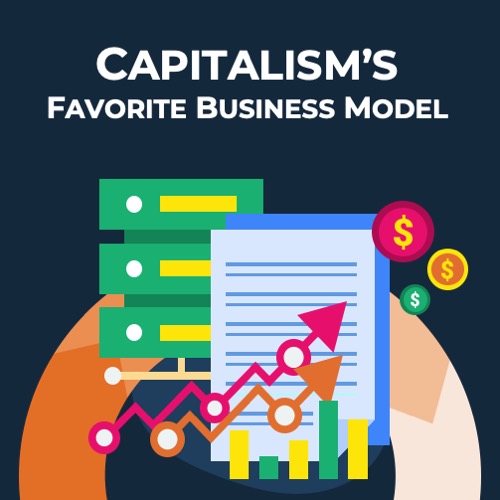
The Ordway Podcast
Capitalism’s Favorite Business Model
Steve Keifer, CMO of Ordway, explains how businesses have shifted from selling things “as-a-product” to delivering them “as-a-service.” Some of the best examples are industries such as media and entertainment (think Netflix and Spotify) and technology (think Salesforce or AWS).
Episode Summary
The biggest driver for the shift towards as-a-service is the desire to increase recurring revenue. Investors award premiums to businesses with recurring revenue due the predictability and consistency produced from the long-term contracts with fixed monthly fees. While some industries have mastered the as-a-service model many others are still experimenting with how best to make it work. Examples include the retail, automotive, and industrial manufacturing sector.
Some industries have shifted from selling things “as-a-Product” to “as-a-Service”
Over the past 20 years, there’s been a dramatic transformation in how certain industries sell their goods and services. We’ve seen a handful of industries really evolve from the traditional model of selling things as a product on a one-time transactional basis to selling things as a service, and more of a long-term contract type of model. Now, the best example of that is probably in the media and entertainment space as companies like Spotify and Netflix have changed the way that we all think about purchasing and consuming everything from audiobooks and music to movies and TV. But it’s not just the media and entertainment space. We’ve seen this kind of transformation in certain pockets of consumer products as well. So take the health and beauty category. Companies like Harry’s and Dollar Shave Club have taken everyday consumer packaged goods and transformed them into subscription models. We also see a lot of experimentation in the apparel and footwear space as companies like Rent the Runway and Stitch Fix are really forcing consumers to reevaluate how they think about the relationship with clothing and whether they really need to own it or not. And of course, one of the huge ones is in the technology space. Companies like Microsoft and Amazon have really shifted the way that businesses buy data center equipment. No one purchases servers or storage or networking equipment anymore. They pry it as a service on an hourly basis for a fraction of a penny. The same kind of transformations occurred in the software space. Companies like Salesforce, Workday, HubSpot have transformed the way businesses buy software. No one purchases perpetual licenses anymore. They rent it on an as a service basis.
Others industries are in early stages still experimenting with “as-a-Service” models
Now, while some industries have cracked the code on this type of as a service model, there’s a lot that are still trying to figure it out and they’re experimenting and innovating. A good example of that is in the retail space. So we see even some of the biggest companies like Best Buy and Walmart trying to figure out subscription models and try to catch up to the giant competitive mode that Amazon has built around their prime service. We see food service operators like Panera and Taco Bell experimenting with subscription models, trying to drive more foot traffic into their retail locations. The automotive industry is trying to move to as a service model instead of just one-time vehicle sales every five or seven years to consumers. Each of the major vehicle manufacturers has introduced the car as a service model in the past couple of years. Now, while those largely have not caught on, what has caught on are connected services they sell as aftermarket products to vehicle owners. The best example of that is probably Tesla’s autopilot, self-driving service, and BMW charging people for heated seats. That same type of innovation though is occurring in other parts of manufacturing as well. We see industrial companies like Kaiser offering compressed air as a service. We see Mitsubishi offering building elevators as a service. We see Michelin offering truck tires as a service. And if you think about it, over 50 years ago, Rolls Royce was really the pioneer when they introduced their power-by-the-hour engine as a service.
Recurring revenue is the driver for the shift to “as-a-Service”
So why are so many different industries experimenting with this shift from as a product to as a service? Well, it’s because the as a service model enables you to generate recurring revenue. If you can get a customer to sign up to a one, two, three, five year contract where they commit to spend the same amount every year or every month, rather than these lumpy one-time transactional sales, you get much greater levels of predictability and visibility into future revenue streams in a way that no other business model can deliver. Another great thing about the recurring revenue model is that you’re more insulated from the ups and downs that occur in the economy. If you’ve locked customers into two or three-year contracts, you’re less susceptible to change in their buying patterns as a result of rising interest rates or government shutdowns or global pandemics or supply chain shortages. Even if you lose a major account with a recurring revenue model, the impact of that is not a precipitous decline in revenue in the next month. Because of the way the GAAP accounting rules work, most recurring revenue is recognized ratably on a straight-line basis across the term of the contract. So if you have a customer on a two-year contract, you might only lose 1/24th of their revenue in that first month, and you have the opportunity to upsell, cross-sell, and acquire new customers to make that up in a relatively short period of time. These are just a few of the reasons that investors and finance professionals love recurring revenue and we say that it’s capitalism’s favorite business model.
Business model innovation and recurring revenue
In this podcast, we’re gonna be focused primarily in a technology space. And we’re gonna be looking at four different dimensions of how technology businesses are running the recurring revenue models. The first is innovation around the business model itself. And you’ll find that some of the biggest tech companies out there have moved beyond just selling hardware and software, but they’ve moved into adjacent markets like the financial services space. Many of the bigger tech companies are now offering products that you might expect to buy from a bank or a financial institution. For example, a lot of the accounts payable, accounts receivable, e-commerce, point of sale vendors are generating a high percentage of their revenue from processing payments. Some have even moved into offering small business loans to provide working capital and equipment financing to startups that are using their products. Others have moved into payroll processing. We see some moving into workers’ comp benefits and other types of insurance. Another innovation in business models is a lot of the bigger platforms are figuring out how to monetize their user community that they have captive on a day-to-day basis on their platform. And so they’ve introduced app stores, marketplaces where everything sold on it, they take a percentage of the revenue, much like Apple and Google do when you download something to your phone. Some are even selling digital advertising services to sell to the captive audiences on their platforms and they charge third parties based on the number of impressions or clicks or conversions that occur.
Pricing strategies for recurring revenue
The second area that we’re gonna explore in the podcast is around pricing strategies. And there’s three big pricing strategies that we see commonly in the recurring revenue space. The first is what’s known as subscription pricing, where you pay a fixed fee throughout the duration of the contract. So think about the per user per month fee that you might pay a CRM vendor like Salesforce or a collaboration vendor like Asana. The second model is around consumption. So there’s a variable fee that can change every month based on how much of the product that you use. So think about the consumption type of pricing model that any Amazon Web Services or Microsoft Azure might have, or how you pay Snowflake to manage your data in the cloud. The third model is also variable going up and down, but instead of being based on usage, it’s based on the percentage of the dollar values of transactions processed on a platform. So think about how Stripe charges to collect credit card payments for online transactions. Think about how Shopify charges some of its customers based on a percentage of the order value. Think about how Toast charges based on a percentage of the gross merchandise value processed across its platform. Now there’s a lot of healthy debate in the industry about which of those pricing models is the best, but the smartest companies have actually figured out that they’re not mutually exclusive and that the best model is figuring out what pricing strategy to offer to different types of customers for different types of products and the ability to pull all three of those levers to grow your revenue as fast as possible.
Next generation technology enables recurring revenue
Now, all this innovation of business models and pricing strategies introduces some pretty extraordinary economics into the SaaS and cloud space, but it also introduces a lot of operational complexity. Everything from sales and contracts to billing and revenue recognition gets a lot more complex in all these different types of innovative models. So let’s dig deep into one, for example, that we’re particularly passionate about at Ordway, which is billing. A lot of companies are adopting these new types of billing metrics. Instead of charging per users, they may charge based on the number of API calls that you have in any given month. And while that sounds really cool, it introduces a lot of complexity in something simple like figuring out how much to charge each customer at the end of the month. So if you have an API-driven pricing model, you might have trillions and trillions of different transactions that you’ve got to synthesize every month and group by customer and by product. You have to filter out duplicates, failed transactions, other types of things that you might not bill for or things that are free. And that’s just to figure out the quantity of what any individual customer used. The pricing is complicated as well because for those kinds of API driven and event driven business models, there are also volume discounts that change based on how much you use in any given month. So you might pay one price for zero to five million API calls, but then you get a discount if you go from five to 10 million and an even bigger discount if you’re in the 10 to 20 million dollar range. Contract structures for these new types of billing metrics are complicated as well. For example, a company with API-based pricing model might ask their customers to commit to buying a certain number of API calls in advance, using something called prepaid credit. So maybe I prepay to have 100 million API calls this year. And each month, I can draw down against that $100 million balance until I deplete it completely, and then I need to buy more. So in many cases, there may not even be a need to invoice the customer on a day-to-day, month-to-month basis if they have a positive credit balance. Now, all these things are just examples of operational complexity. And the third area that we’re going to be exploring in the podcast is how AI and the next generation of technology are going to actually help SaaS and cloud companies scale these more innovative business models.
Operating metrics and KPIs for recurring revenue
The fourth and final area is around operational metrics and KPIs. And so here I’m talking about things like ARR, MRR, gross retention, net retention, CAC, LTV. And there’s a lot of change and evolution going on in those metrics as well, because as we move into financial services and marketing services and introduce new types of pricing models, it’s broken the traditional formulas and standardized ways that companies use to calculate things like ARR and net retention. Contrary to popular relief, there isn’t one consistent way that companies are using. There’s a variety of different ways. Even something simple like customer count, you’ll find a wide divergence in the way the companies are calculating that. So for example, if you’re reporting customer count on a quarterly basis, what day of the quarter do you take the measurement? Do you take it on the last day? Or do you take it on the first day and the last day and take the average of the two? What’s an active customer that would be considered in that count? If you have somebody that’s using your service, or still… What’s an active customer? If you have someone that hasn’t canceled but they also haven’t used the service and you haven’t billed them in 12 months, does that get counted as a customer? What about distribution channels and reseller arrangements? If you have a reseller that has 1,000 end customers, does that count as 1,000 customers or one? So you can see how quickly complicated these types of things get. And there’s a healthy debate going on between the finance and CEOs and various different operational leaders at the SaaS and cloud companies about the best way to calculate these. There’s even a lot more passion that the growth equity and venture firms bring to these metrics because they’re trying to figure out what the leading indicators are they need to measure success so they can figure out who’s gonna be the next $100 million ARR company or billion dollar ARR company.
Join us as we explore recurring revenue – capitalism’s favorite business model
So if you find all these topics as fascinating as we do, we hope that you will join us on this podcast and subscribe. We’re gonna be interviewing a variety of different founders, venture capitalists and other leaders and executives at SaaS and cloud companies to really dig into some of the ways that this recurring revenue business model works and the challenges and complexities that it introduces.
Frequently Asked Questions
What is the ‘as-a-service’ business model?
The ‘as-a-service’ model turns products into ongoing services with recurring payments, such as subscriptions or usage-based fees, instead of one-time sales.
Why do investors prefer companies with recurring revenue?
Recurring revenue creates financial predictability and stability, making companies more attractive to investors due to consistent cash flow and higher valuations.
Which industries have adopted recurring revenue models successfully?
Media, technology, and consumer products have embraced recurring revenue through subscriptions and SaaS, while industries like automotive and manufacturing are experimenting with these models.
How do pricing strategies differ for recurring revenue businesses?
Common strategies include subscriptions (fixed fees), consumption-based (variable fees based on use), and percentage-of-transaction models—sometimes combined for flexibility.
What technology enables scalable recurring revenue for SaaS and subscription businesses?
Cloud-native billing, automated revenue recognition, and AI-driven analytics support the complexities of managing large-scale recurring revenue and innovative pricing structures.
Recent Blog Posts







